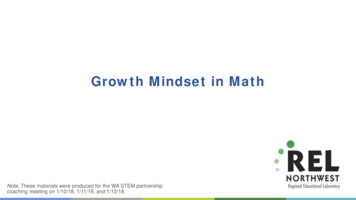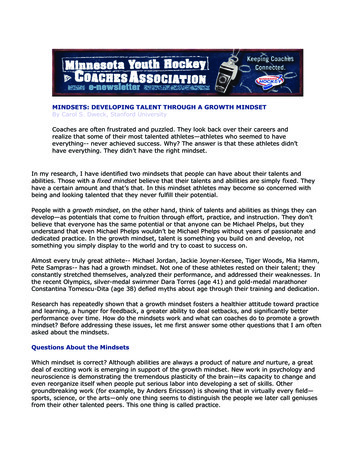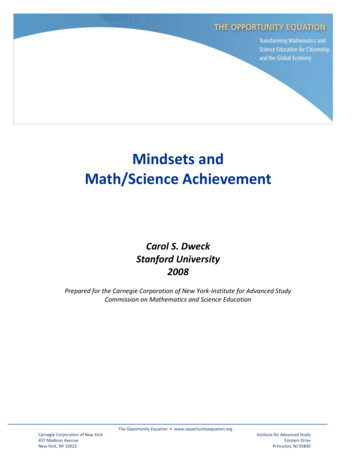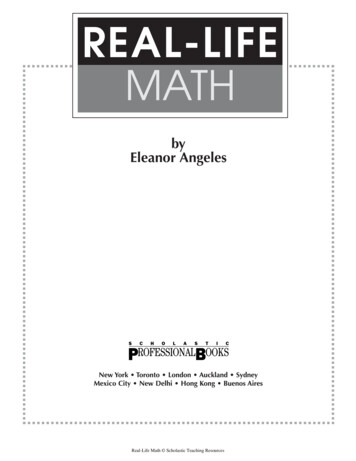
Transcription
Growth Mindset in MathNote. These materials were produced for the WA STEM partnershipcoaching meeting on 1/10/18, 1/11/18, and 1/12/18.
Icebreaker: Manifold Puzzles1. Find the Manifold OrigamiPuzzles on your table.2. Read the directions onpuzzle number 1 and giveit a try.3. Once you’ve completedpuzzle 1, try another one.The higher the number onthe puzzle, the morechallenging it will be.
Icebreaker: Manifold PuzzlesIntroduce yourself to a partner and discuss with each other: What was your initialreaction to the puzzles? Did you feel confident youcould get better at thepuzzles as you worked onthem? What kind of internal selftalk did you have as youworked on the puzzles?
Learning ObjectivesBy the end of this session, you will be able to:Reflect on your mindset about math.Consider how fixed and growth mindsets impact students’learning and engagement in math.Learn and practice strategies to promote growth mindsets inmath classrooms.
What Are Mindsets?FixedMindsetIntelligenceand abilityare fixedqualitiesfrom birththat cannotbe changedsignificantly.GrowthMindsetIntelligenceand abilitycan bedevelopedwith effort,strategies,andsupport.
Fixed vs. Growth MindsetFixed mindset“I failedbecause I’mdumb.”Bad grade ona quizGrowth mindset“Maybe I need anew strategy.”
Different Mindsets for Different Topics
Mindsets and Math Students develop mathskills incrementally overmany years.However, many peoplebelieve math ability isinnate—it’s naturally easyfor a math “genius” but notfor anyone else.
Students’ Mindsets Influence Behaviors andAchievementAcademicMindsetAdapted from Farrington (2013)AcademicBehaviorsAcademicOutcomes
Growth Mindset Is an Academic MindsetFarrington’s Four KeyAcademic Mindsets:1. I belong in this community2. I can succeed at this3. My ability and my competencegrow with my effort4. This work has value for meThis is Growth MindsetAdapted from Farrington (2013)
Growth Mindset and MathStudent mindset predicts mathsuccess Students with growth mindsets hadbetter math grades and test scoresthan students with fixed mindsets. Students with growth mindsetstransitioned more successfully fromelementary to junior high school math.Blackwell, Trzesniewski, & Dweck (2007)
Growth Mindset and MathStudies with many different kinds of students havefound a robust relationship between mindset andmath achievement. A study of virtually all grade 10 students in Chilefound students’ mindsets predicted their languageand mathematics achievement. Although low-income students had lower test scoresoverall, low-income students with growth mindsetsperformed as well as students with much higherincomes.Claro, Paunesku, & Dweck (2016)
How Does Growth Mindset Impact MathAchievement?When students have a growth mindset, they are morelikely to: Believe that effort pays off. (“The harder you work atsomething, the better you will be at it.”) Set learning goals for themselves. (“The main reason Ido my schoolwork is because I like to learn new things.”) Believe effort-based strategies will help them overcomefailures. (“If I got a bad grade, I would work harder.”)Blackwell, Trzesniewski, & Dweck (2007)
How Does Growth Mindset Impact MathAchievement?When students have a growth mindset, they are LESS likely to: Attribute failures to things they cannot control (“The test was unfair.”)In sum, the research suggests thatstudents with growth mindsets arewilling to put in effort even whenthey struggle or fail, and they stayfocused on what they can learn.These behaviors result in bettermath performance over time.
How Does a Fixed MindsetImpact Learning?Research using scans of electrical activity in the brain (eventrelated potentials or ERPs) shows that students with fixedand growth mindsets have different patterns of brain activity. Students with fixed mindsets have stronger reactions to negativefeedback (e.g., learning they got a quiz question wrong) . . yet, spent less time attending to feedback that would helpthem learn (e.g., less time thinking about the correct answersonce they were provided) and learned less.Mangels, Butterfield, Lamb, Good, & Dweck (2006)
How Does a Fixed Mindset Impact Learning?These results illustrate thatstudent beliefs aboutintelligence influence theirlearning, because thosebeliefs change how they focustheir attention and the effortthey make to remember newmaterial.Mangels, Butterfield, Lamb, Good, & Dweck (2006)
Influence of Teacher to Students
How Do Teacher Mindsets Impact Students?Teachers’ mindsets influence theirpedagogical decisions. When a student is struggling with math,a teacher with a fixed mindset maychange their pedagogy fromchallenging to comforting, such asassigning less math homework to thestudent.Rattan, Good, & Dweck (2012)
How Do Teacher Mindsets Impact Students?Ability grouping or tracking implicitly communicates thatteachers have a fixed mindset about students’intelligence and even potential. British students placed in tracked math classes said schoolfelt like a “psychological prison” that “breaks all [students’]ambition” because it “almost formally labels kids as stupid.” Even very young students noticed ability grouping, such asone kindergarten student who said “All the clever studentshave gone into a different class now.”Boaler (2005; 2013)
How Do Teacher Mindsets Impact Students?Research has found that students in heterogeneous classesachieve more than students in ability-grouped classes When an American school district stopped using ability grouping inmiddle school math classes so that all students took rigorous mathclasses: More students took advanced math classes in high school More students passed their math classes Students earned higher scores on the state math exam The achievement gap between white and minority studentsnarrowed dramatically These results were consistent whether students started middleschool with high or low math achievement.Burris, Heubert, & Levin (2006)
How Do Teacher Mindsets Impact Students?Teachers’ mindsets alsoinfluence their feedback tostudents. When a student is strugglingwith math, a teacher with a fixedmindset may try to comfort thestudent instead of giving themstrategies to succeed in math.Rattan, Good, & Dweck (2012)“Plenty of people havetrouble in [math] butgo on to be verysuccessful in otherfields.”
How Do Teacher Mindsets Impact Students?Math students who received“comforting” feedback believed theteacher had low expectations forthem in math, had lower motivation,and had lower expectations forsuccess in math.Rattan, Good, & Dweck (2012)
How Do Teacher Mindsets Impact Students?Praising students’ intelligence instead of theireffort has negative consequences: Students become more focused on performance than onlearning (proving it rather than improving it) They demonstrate less task persistence, less enjoyment,and lower performance when they experience setbacks,compared to children who are praised for their effort They describe their own intelligence as a fixed entity theycannot changeMueller & Dweck (1998)
How Do Teacher Mindsets Impact Students?Fixed mindset“I failedbecause I’mdumb.”You’re justbetter at artthan at math.Growth mindset“Maybe I needa newstrategy.”You put a lotof work intothat project.
Math Stereotypes and MindsetWhen teachers or students believe in stereotypes about math ability,they are endorsing a fixed mindset about math in which some peopleare naturally more capable at math and others are not.Stereotypes “may constrict children’s aspirations and shape their futureacademic goals and identities” – Cvencek et al. (2015)
Gendered Perceptions of Math“Boys do not pursue mathematicalactivities at a higher rate than girlsdo because they are better atmath. They do so, at leastpartially, because they think theyare better.”—Shelley Correll
Girls and Math Sociocultural stereotypes associating STEM with males act asbarriers that prevent girls from developing interests in STEM, and thisstarts at a young age. Counteracting stereotypes can increase girls’ interest in STEM byincreasing their confidence and making them feel like they belong inmath.CulturalStereotypesSTEM maleAbilityStereotypesGirls haveless abilitythan boysFigure adapted from Cheryan, Master, & Meltzoff (2015)Gender gapsin STEM
“Just Try Harder” Sends a Mixed Message to StudentsYou just need totry harder.I DID try hard,but I still don’tget it. I must notbe cut out forthis.
Growth Mindset & EquityIt is imperative that growth mindset is not oversimplified tojust telling students they need to work harder. Hard work on the part of students fromtraditionally marginalized communities is notenough to overcome systemic racial, gender,and economic oppression. Telling students to “just try harder” places theburden of effort only on their shoulders. Praising effort when students aren’t learningsends the message that learning isn’t theobjective—effort is.
Growth Mindset & Equity Keep the focus on effort in the service ofTRY THISINSTEADDweck (2015)learning. Encourage students to seek out and trynew strategies or seek assistance fromothers when they’re stuck. When students are trying but notlearning, appreciate their work so far, butthen talk about what they can try next.
Growth Mindset & EquityFostering a growth mindset canhelp change student engagement inSTEM: Influences the motivation andaspirations of aspiring clinicians inorganic chemistry. Positively impacts minority studentsconfronting stereotypes about theirrace and perceived intelligence.Grant & Dweck (2003); Aronson, Fried, & Good (2002)Sally RideFirst American Woman to Visit Space
Research Jigsaw, Part 11. Find the Jigsaw Readings handout. Select theresearch study you’re most interested in.2. Move to the poster paper with thecorresponding study number (1‒4).3. Read the study summary independently.4. With this group (your “expert” group) discussand write notes on the poster paper:How would you describe this research and its implications?What relevance does this have to you and your role?
Research Jigsaw, Part 2 Now mix it up! Create new groupswith each poster number (1‒4) andstudy represented. Have one volunteer from eachexpert group spend 2 minutessummarizing what they learnedabout the study they read anddiscussed.
Break
ClassroomStrategiesto PromoteGrowth Mindset
Key Strategies Create a positive classroomclimate for learning and math. Give feedback that promoteseffort and learning. Teach about how learninghappens in the brain.
Positive Climate IdeasPositive classroomclimate: Everyone can learnMistakes are learningexperiencesHelp is availableEffort is expectedPositive studentacademic mindset: Failure or mistakes are partof my learning processPractice makes me smarterMy effort pays off
Positive Climate for MathCreate the norm that making mistakes is OK Let students know that you embrace mistakes aspart of the learning process. Have studentspresent their mistakes on the board—otherstudents often have made the same ones andcan learn by example. Explain why mistakes are important—they arechances to learn and get smarter. Assign work that encourages mistakes—ifstudents aren’t making mistakes, then the work isnot challenging enough for them.Adapted istakes/3-ways-to-celebrate-mistakes-in-class
Positive Climate for MathCreate non-stereotypical environmentsfor math learning: Make classrooms—even computer andscience labs—more welcoming withplants and wall art (especially images ofnon-stereotypical STEM role models,such as women and people and color). Use social media to show the diversityof people working in STEM.Master & Meltzoff (2017)
Positive Climate for MathTeach about and celebrate diverse STEM role models,sending the message that it is normal—not exceptional—for STEM practitioners to be diverse.MathematicianMaryam MirzakhaniMaster & Meltzoff (2017)AstrophysicistNeil deGrasse Tyson
Key Strategies Create a positive classroomclimate for learning and math. Give feedback that promoteseffort and learning. Teach about how learninghappens in the brain.
Give Formative Feedback,Not GradesStudents learn more when they are givendescriptive, formative feedback. Students given grades or grades withdescriptive comments learned less andwere less interested in working more thanstudents who were only given commentsabout their work.Butler urage-growth-mindset
Praise the Process, Not the PersonDifferent types of praise promote different mindsetsFixed MindsetPraise about theperson/their intelligenceYou must be smartat these problems.Mueller & Dweck (1998)Growth MindsetPraise about theprocess/effortYou must haveworked really hardat these problems.
Praise the Process, Not the PersonPerson/IntelligenceProcess/EffortGreat job! You must be smartat this!Great job! You must have worked really hard.See, you are good atEnglish. You got an A on yourlast test.I know you are a talentedstudent in general—it’s justnot the case that everyone isa math person.You really studied for your English test andyour improvement shows it.I know you can solve this problem because Iremember last month when we worked oncommon denominators. That was hard, butyou did it! Let’s talk about a new strategy youcan try to solve this math rocess-not-person/dos-donts-of-praiseRattan, Good, & Dweck (2012)
Activity: Improving Praise Find the sticky notes with examples of praise. Discuss each example as a group. Would it promote agrowth mindset or a fixed mindset? Revise examples as needed to promote a growth mindset.
Key Strategies Create a positive classroomclimate for learning and math. Give feedback that promoteseffort and learning. Teach about how learninghappens in the brain.
How Does Learning Happen?Our brains change as we learn—they grow newconnections between neurons, creating networks ofinterconnected neurons.People who have learnedmore or have moreexperience have densernetworks of neurons intheir brains.Yeager et al. (2016)
How Does Learning Happen?“Most people don’t know that when they practice and learn newthings, parts of their brain change and get larger, a lot like themuscles do. This is true even for adults. So it’s not true that somepeople are stuck being “not smart” or “not math people.” You canimprove your abilities a lot, as long as you practice and use goodstrategies.”‒ Excerpt from You Can Grow Your Brain byLisa S. Blackwell and David S. YeagerVisit Mindsetworks.com for more informationabout articles and other activities
How Does Learning Happen?Several research teams have testedstrategies for teaching students how theirbrains grow and get smarter when they’rechallenged—similar to how muscles respondto physical exercise—and that students arein charge of this growth process.Blackwell, Trzesniewski, & Dweck (2007)Yeager et al. (2016)
How Does Learning Happen?Another useful analogy for teaching this concept to children isthat babies start out ignorant but become smarter over time asthey learn more things about the world.Blackwell, Trzesniewski, & Dweck (2007)
Activity: You Can Grow Your Brain1. Students read the You Can GrowYour Intelligence article.2. Students think about something theycouldn’t do very well, but then theypracticed and got better at it.3. Students write a letter ofencouragement (a short paragraph)to an imaginary future student whois struggling in school and feeling“dumb” as a result.
ReflectionWhat stood out for you,increased your knowledge, orchanged your thinking duringthis session?What is one thing you learnedor discussed today that youwill take back and apply toyour work with teachersand/or your classroom?
ReferencesAronson, J., Fried, C., & Good, C. (2002). Reducing the effects of stereotype threat on African American collegestudents by shaping theories of intelligence. Journal of Experimental Social Psychology, 38, 113-125.Blackwell, L. S., Trzesniewski, K. H., & Dweck, C. S. (2007). Implicit theories of intelligence predict achievement acrossan adolescent transition: A longitudinal study and an intervention. Child Development, 78, 246-263.Boaler, J. (2013). Ability and mathematics: The mindset revolution that is reshaping education. FORUM, 55(1), 143-152.Boaler, J. (2005). The ‘psychological prisons’ form which they never escaped: The role of ability grouping in reproducingsocial class inequalities. FORUM, 47(2), 135-144.Burris, C. C., Heubert, J. P., and Levin, H. M. (2006). Accelerating mathematics achievement using heterogeneousgrouping. American Educational Research Journal, 43(1), 105-136.Butler, R. (1988). Enhancing and undermining intrinsic motivation: The effects of task-involving and ego-involvingevaluation on interest and performance. British Journal of Educational Psychology, 58(1), 1-14Cvencek, D., Meltzoff, A. N., & Greenwald, A. G. (2011). Math-gender stereotypes in elementary school children. ChildDevelopment, 82, 766-779.Cvencek, D., O’Connor, K., Wischnia, S., Nasir, N. S., and Meltzoff, A. N. (2014). The development of math-racestereotypes: “They say Chinese people are the best at math.” Journal of Research on Adolescence, 25(4), 630637.Dweck, C. (2015, September 22). Carol Dweck revisits the ‘growth mindset.” Education Week. Retrieved gton, C. A. (2013) Academic mindsets as a critical component of deeper learning. Chicago: University of ChicagoConsortium on Chicago School Research. Retrieved from Academic Mindsets as a Critical Component of Deeper Learning CAMILLE FARRINGTON April 20 2013.pdf
ReferencesGrant, H. & Dweck, C. S. (2003). Clarifying achievement goals and their impact. Journal of Personality andSocial Psychology, 85(3), 541-553.Mangels, J. A., Butterfield, B., Lamb, J., Good, C., & Dweck, C. S. (2006). Why do beliefs about intelligenceinfluence learning success? A social cognitive neuroscience model. SCAN, 1, 75-86.Master, A., and Meltzoff, A. N. (2017). Building bridges between psychological science and education: Culturalstereotypes, STEM, and equity. Prospects: Quarterly Review of Comparative Education, 46(2), 215-234.Mueller, C. M., & Dweck, C. S. (1998). Praise for intelligence can undermine children's motivation andperformance. Journal of Personality and Social Psychology, 75(1), 33-52.Rattan, A., Good, C., & Dweck, C. S. (2012). “It's ok—Not everyone can be good at math”: Instructors with anentity theory comfort (and demotivate) students. Journal of Experimental Social Psychology, 48(3), 731-737.Yeager, D. S., Romero, C., Paunesku, D., Hulleman, C. S., Schneider, B., Hinojosa, C., et al. (2016). Usingdesign thinking to improve psychological interventions: The case of the growth mindset during the transitionto high school. Journal of Educational Psychology, 108(3), 374-391.
Bonus Activity: Mindset Quiz1. Please fill out the Mindset Quiz, score your responses, and read aboutyour score using the handout provided.2. Next, discuss the following questions with a partner:What stood out to you about your score?Think about your experiences as a math student. What mindset aboutmath do you have, based on those experiences?How could a teacher’s personal mindset about math influence theirmath teaching?
About REL NorthwestRELs partner with practitioners andpolicymakers to use data andevidence to help solve educationalproblems that impede studentsuccess. We do this by: Conducting rigorous research anddata analysis Delivering customized training,coaching, and technical support Providing engaging learningopportunities
Contact Uswww.educationnorthwest.orgEducation Northwest@educationnorthwest101 SW Main Street Suite 500Portland, OR 97204-3213@educationnw1.800.547.6339
Growth Mindset in Math Note. These materials were produced for the WA STEM partnership coaching meeting on 1/10/18, 1/11/18, and 1/12/18. Icebreaker: Manifold Puzzles 1. Find the Manifold Origami Puzzles o










